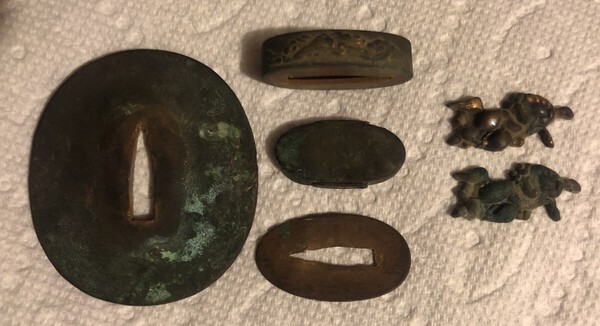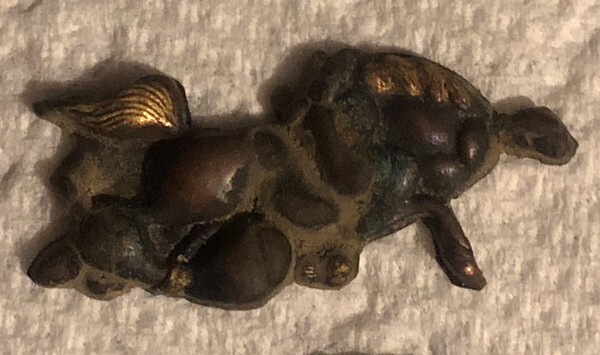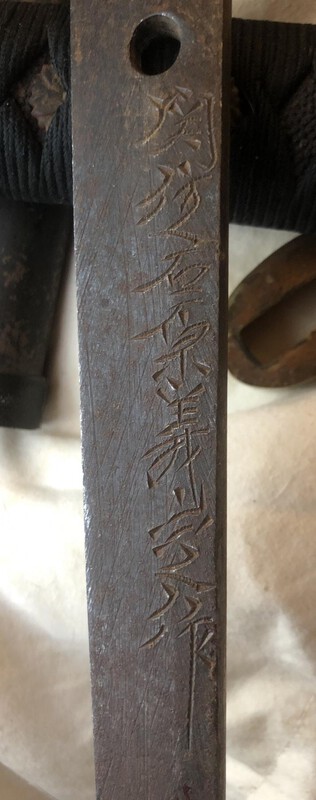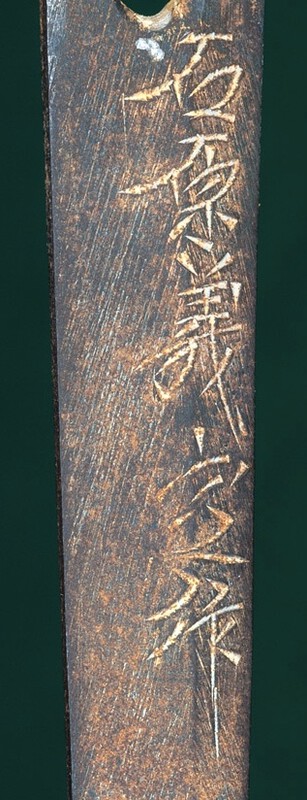
Chasing
Members-
Posts
10 -
Joined
-
Last visited
Content Type
Profiles
Forums
Events
Store
Downloads
Gallery
Everything posted by Chasing
-
Were children's swords ever made?
Chasing replied to Chasing's topic in General Nihonto Related Discussion
The seeming lack of differential hardening is actually one of the things that made me think it had been made for a child - I would certainly ask a smith to skip the 'make it extra-deadly' steps myself! If that's unexpected though, I live in Rochester, NY. I know there's a Rochester Sword Study Group here but they don't have public meetings; if you know of anyone nearby or know that group is credible I'd gladly contact them and meet up to get an in-person assessment. You also mentioned Boy's Day swords were made for samurai families in particular, but as they haven't existed in a while, I'm adding a few pictures of the fittings that came off the koshirae in case they help narrow down when the blade was last mounted. It seemed custom-made; I don't think it was cannibalized from another blade. Tsuba seems to be solid copper, menuki either copper or a mix of copper and something else, the rest I'm not sure about. - Carmen G -
Were children's swords ever made?
Chasing replied to Chasing's topic in General Nihonto Related Discussion
Experiment is probably the wrong word; it sounds like Brian already did the experimentation. I'd just be following the process he laid out here for a similarly rusty sword: -
Were children's swords ever made?
Chasing replied to Chasing's topic in General Nihonto Related Discussion
Oh, that's beautiful! Your swords' child must have been much better behaved. Sounds like it's a good piece for experimentation then. I think I saw Brian talk about using an evaporust dip to get rid of rust in another post; that seems like a good starting point. I'll re-read it and see if it's suitable to try, and give updates if anyone wants them about how it affects the blade. - Carmen G -
Were children's swords ever made?
Chasing replied to Chasing's topic in General Nihonto Related Discussion
Some pictures of the epic-in-its-own-way damage this thing has: a few of the mune, the tip, the cutting edge, and one where it looks like it was hit against a tree or something? hard enough to bend the whole midsection out of shape. Insane that it's still in one piece (and kinda sharp!) - Carmen G -
Were children's swords ever made?
Chasing replied to Chasing's topic in General Nihonto Related Discussion
Quick comparison between the baby waki and a (regular) waki I have with a same-length cutting edge. Sorry if the photos are bad, I'll retake/take more if needed. + / - added for slightly larger or smaller measurements than the number given. Motokasane - Baby: 2/16in Reg: 3/16in+ Sakikasane - Baby: 2/16in- Reg: 2/16in Motohaba - Baby: 14/16in Reg: 15.5/16in Nakago - Baby: 3in Reg: 5in Last picture shows shinogi placement. -
Were children's swords ever made?
Chasing replied to Chasing's topic in General Nihonto Related Discussion
It's visibly delicate, and I hope I get the terms right here - the kasane (thickness?) and motohaba (height?) both seem finer than on a "normal" waki. I just assumed at the time that it was several steps beyond tired and that was why it had been left to rust, but the shinogi seems to be in the right place and the mune looks unaltered so I don't think material was removed. I think it was made like that. I can't speak to the shape. It's been through a lot and looks straighter than I would expect (and straighter than its saya) but I think that may be the result of a particularly hard impact? I'll be uploading pictures later which will hopefully help. - Carmen G -
Were children's swords ever made?
Chasing replied to Chasing's topic in General Nihonto Related Discussion
Excellent! Thank you guys for the info! I looked up some pictures of Boys Day swords and this may be a mystery solved. I'll post some pictures when I get home tonight and see if we can confirm it. This seems accurate. It does seem to be proportioned like a small katana, although it doesn't appear to have kissaki geometry. Whether it started like that or has been lost over time I can't tell (hopefully the pictures will help). Very true, but this seemed next-level which is why my mind went to kids. The mune and cutting edge each have a few dozen impact-chips out of them, the point is intact but literally bent over, and the tang was stuck in the tsuba because at some point it impacted something so hard head-on it was jolted back into the uncarved, solid wood and lodged into place. I'll try and get all the damage in the pictures as well, it's impressive in its own way. - Carmen G -
Title is self-explanatory, but here's the short story of why I ask: I'm pretty new to collecting swords, and I bought a sad sack of a wakizashi very cheap for the metal fittings. The blade was totally rusted - apparently into place - and the koshirae was wrecked and I think at once time covered in mold. But the fuchi and menuki looked like they might be nice. So I disassembled it, which left me with the fittings (I'm happy with them) and the rusty blade. An abundance of caution later and I decided to either remove the rust or fix it in place, on the off chance it's 1) not as bad as it looks somehow or it's 2) something worth preserving even though it IS as bad as it looks. A search on the forum reveals a way forward. SO, I've spent a good 15+ hours staring intently at this thing's minor details while gently scraping it with an old Canadian penny. And I'm noticing a lot of things that make me think that this was used and VERY abused by a pretty young child, and also that it was *meant to be*. It's messing with me. I've read a few books but don't remember any "Katanas for Kids" chapters, so I'm hoping to get help from the experienced people here: Were swords ever made for children? - Carmen G
-
Hi everyone! I've just joined recently but I've been lurking about for about a month and have a few questions about polishing that I'd like to get others' points of view on. Feel free to add to/correct anything I have here, I've been admiring nihonto from afar for a long time now but only recently started actually learning about it, so it is what it is. First - everything I've been reading about polishing has an introduction that can be summarized as "don't you dare do it you're going to ruin EVERYTHING you absolute nincompoop", so I'm going into it with the expectation that no matter how careful I am, something will go wrong. Now that that's out the way - I've bought a few whetstones that are 3000/8000 grit and a nagura that's 8000 (assuming these are Japanese grit #s so I err on the safe side), and I have no intention of doing any reshaping. I know I can't be trusted with that, so it's going to be straight polishing to minimize risk. What I haven't done yet is buy the oil/supplies to finish it with. I've read Choji oil is what I need, but I'm wondering if there's a favored company to get it from, and what best to apply it with? Next, I have four blades total. Three of them are unmarked, unpolished (combat-polished?) "mystery swords" that I picked up fairly inexpensively (they may be awesome! they may be junk!), and one is a signed blade from WWII with the Seki blossom mark. Because I trust the guides and am assuming something will go wrong - and because I don't want to risk ruining one of the blades I bought to keep, be they trash or treasure - I'm tempted to buy a new blade. I was thinking of the cheaper, likely-machined WWII-era army/police swords that are always up on eBay for $200-$300 so that worst case I basically can't "ruin" it, and best case I make it a decent-looking sharpy-shiny and I have a chance of just reselling it and getting that money back. What does everyone think? I can't think of anything else to practice with that has naki, and I figure at least getting used the overall curved shape is better than nothing, but I'm very open to suggestions.
-
This post is very old but I came across it in a Google search, and finally made myself an account, to say - over at the Oshigata database of WWII smiths there's one example of his signature. I found it while trying to figure out the signature on a sword I bought just a lil bit ago - which, it turns out, was also made by Ishihara Yoshisada. There's also another one up for sale on Hallowell & Co. I've compiled pictures of all relevant tangs for comparison/reference. The signature varies very little stylistically, which is *SO* nice.



















